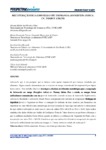Please use this identifier to cite or link to this item:
http://www.alice.cnptia.embrapa.br/alice/handle/doc/1032506| Title: | Recuperação de Salmonella spp. em manga (Mangifera indica) cv. Tommy Atkins. |
| Authors: | VILAR, S. B. de O.  CASTRO, M. F. P. P. M.   REZENDE, A. C.   PENTEADO, A. L.   SCHMIDT, F. L.   |
| Affiliation: | SILVANA BELEM DE OLIVEIRA IVLAR, FEA-UNICAMP; MARIA FERNANDA PONTES PENTEADO MORETZHON DE CASTRO, ITAL; ANA CAROLINA REZENDE; ANA LUCIA PENTEADO, CNPMA; FLAVIO LUIS SCHMIDT. |
| Date Issued: | 2015 |
| Citation: | Perspectivas Online: Biológicas e saúde, Campos dos Goytacazes, v. 17, n. 5, p. 1-8, 2015. |
| Description: | Resumo: Salmonella spp. é um patógeno que se destaca como agente responsável por doenças veiculadas por alimentos. Alguns estudos demonstram que o consumo de manga contaminada foi responsável por alguns destes surtos. Este trabalho objetivou investigar a eficiência de diferentes metodologias para a recuperação de Salmonella em manga (Mangifera indica) cv. Tommy Atkins. Para o estudo, as mangas foram artificialmente contaminadas com um pool de Salmonella contendo culturas de Salmonella Typhimurium, Salmonella Enteritidis e Salmonella Brasil. Foram comparados dois métodos de recuperação: esfregaço de superfície (Swab) e fragmento do fruto. A contagem foi realizada de duas maneiras: por semeadura em superfície em meio MLCB e pela metodologia de duas camadas de ágar (ágar não seletivo + sobrecamada de ágar seletivo) utilizando-se neste caso os meios de cultura TSA +MLCB ou TSA + XLD. Após análise estatística dos dados obtidos por análise de variância e teste de Tukey observou-se que houve diferenças eque os melhores resultados foram obtidos quando se utilizou a combinação do fragmento do fruto, com a recuperação nos meios TSA + MLCB. Concluiu-se que esse método foi eficiente na recuperação de cepas de Salmonella artificialmente inoculadas em mangas cv. Tommy Atkins no estádio de maturação 2. Abstract: Salmonella spp. is a pathogen that stands out as an agent responsible for foodborne illnesses. Some studies have shown that consumption of contaminated mango was responsible for some of these outbreaks. This study aimed to investigate the effectiveness of different methodologies for Salmonella recovery in mango (Mangifera indica) cv. Tommy Atkins. For the study, the mangoes were artificially contaminated with a pool containing cultures of Salmonella Typhimurium, Salmonella Enteritidis and Salmonella Brazil. Two recovery methods were compared: Surface Smear (Swab) and Fragment Fruit. Counting was done in two ways: sowing Surface among MLCB and by the methodology of two layers Agar (non-selective agar + selective agar overlay) using, in this case, the TSA culture media + MLCB or TSA + XLD. After statisticalanalysis of data obtained by ANOVA and Tukey test it was observed that there were differences and that the best results were obtained when using the combination Fragment Fruit with the recovery in the TSA + MLCB medium. It was concluded that this method was effective in the recovery of Salmonella strains artificially inoculated in mangoes cv. Tommy Atkins in the maturation stage 2. |
| Thesagro: | Manga Salmonella spp Salmonelose |
| NAL Thesaurus: | Mangoes Salmonellosis |
| Keywords: | Doenças veiculadas por alimentos Foodborne illnesses |
| Type of Material: | Artigo de periódico |
| Access: | openAccess |
| Appears in Collections: | Artigo em periódico indexado (CNPMA)  |
Files in This Item:
| File | Description | Size | Format | |
|---|---|---|---|---|
| 2015AP18.pdf | 212,21 kB | Adobe PDF |  View/Open |









